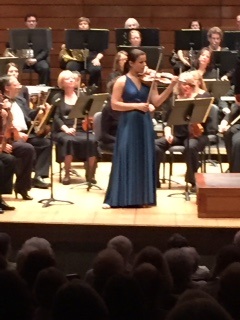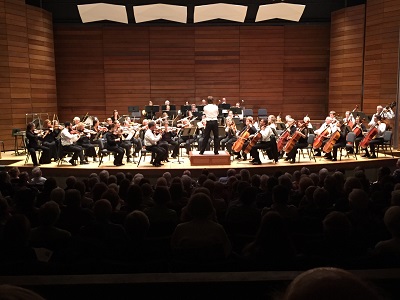Five years ago when Martin Majkut took over the reigns as Music Director of the Rogue Valley Symphony, he quickly transformed a moribund little local orchestra into a top notch regional symphony orchestra, bringing high energy to the task of running the orchestra and it’s musicians, offering new pieces of music as well as a fresh outlook and insight into the standard classical repertoire, drawing quality musicians into the orchestra and “A” list soloists to join in its performances, and demonstrating an uncanny knack for assembling compelling and exciting concert programs. One might well wonder if he could keep it up after 5 years. Friday evening, when the Symphony launched Masterworks Concert I of the 2014-2015 season, we got the answer, and it was a resounding “YES!” In fact, after 5 years, the Rogue Valley Symphony and their concert program seem to have gotten even better.
Majkut put together a remarkable program of 3 pieces for this first concert of the season. He began with a contemporary piece, Oaken Sky, by 26 year old composer, Chris Rogerson, who is the hot new commodity now in contemporary composers among major American orchestras. His works have been or will be played recently by the Amarillo Symphony, New World Symphony, Atlanta Symphony Orchestra, New Jersey Symphony, Spokane Symphony Orchestra, Kansas City Symphony, Buffalo Philharmonic Orchestra, and now the Rogue Valley Symphony. Oaken Sky was the perfect piece to open the program, and the new season. At 7 minutes, it was like a delectable appetizer at a fine epicurean restaurant, showing off what the kitchen can do, and whetting the appetite for all that would come after. Rogerson employs the full orchestra: woodwinds, brass, strings, harp, celesta, timpani and a warehouse of various percussion instruments all have significant parts to play, providing opportunities to show off each of the orchestra’s different sections. The piece can best be described as Impressionist Music, setting an atmosphere and conveying mood, rather than presenting a detailed tone-picture. The composer describes the work saying “Imagine it’s night and you are standing under a tree looking at the stars. Some of the light . . . is blurred by the branches . . . . I try to create this “blurry” effect . . . in addition to moments of pure clarity.” While providing a nice taste of what the orchestra can do, the piece is light and airy, just as a good appetizer ought to be.

Violin soloist Bella Hristova performing Sergei Prokofiev’s Violin Concerto No. 1 with the Rogue Valley Symphony
For the second piece, Majkut managed to snare one of the hottest violin soloists on the scene today, Bella Hristova, and to persuade her to join the Symphony in performing one of the most impressive and difficult violin concertos, Prokofiev’s Violin Concerto No. 1. Prokofiev composed the piece during an illicit love affair and poured all of his passion into this composition and especially the solo violin part. Hristova, a young musician with a growing international career, has won multiple competitions, prizes & grants, and has performed extensively as a soloist with orchestras, including with Pinkas Zuckerman at Lincoln Center, with Jaime Laredo at Carnegie Hall, with the Mississippi Symphony, City of London Sinfonia, Orquesta Sinfonica de Venezuela, Estonian National Symphony Orchestra, and Canada’s National Arts Center Orchestra. Ms. Hristova was superb playing Prokofiev’s Violin Concerto No. 1 Friday evening, executing fast moving passages and playing at the high range of her instrument flawlessly, while conveying all of the intense passion that Prokofiev had invested in this piece. The orchestra was excellent in playing their parts for this piece too, with violas, clarinet, other woodwinds, and violins all contributing significant and outstanding performances, all producing a moving and memorable recital. So Chef Majkut’s second course of the evening was a tasty and satisfying dish.
For the third piece of the evening, after intermission, Majkut gave us the meat of the meal, Beethoven’s Symphony No. 3, “Eroica”. Eroica was a revelation when it was introduced by Beethoven; it was like nothing that came before it, and it changed the face of classical music forever after. Beethoven dispensed with long held symphonic conventions in constructing his Symphony No. 3 and instead pursued innovative ideas and incorporated an unheard of density of ideas in composing the piece. This divergence from convention was apparent from the very outset – Beethoven announced this was going to be something different in the first 8 seconds of this work: Symphonic convention of the era required either a slow introduction or the immediate presentation of the main theme; Beethoven, though, begins with something wholly novel – two sharp full orchestral chords that demand attention announcing the rapid tempo. (You can listen to this surprising and dramatic beginning to the piece for yourself in the 1 minute excerpt recording of Friday evening’s performance which is linked below).
Which brings us back to Mr. Majkut and his unique contributions that make these performances so interesting and compelling. Beethoven specified a very brisk tempo in his markings on the score for “Eroica” – but almost every contemporary conductor ignores Beethoven’s tempo markings and slows the piece down substantially. Maestro Majkut, who has thought this all through, takes a different tact:
“my interpretation is very much informed by the scholars of the authentic performance practice. Although we do not possess period instruments in a modern symphony orchestra, I find that trying to make the piece as “period-correct” as possible produces performance that is surprisingly modern and has a very direct emotional impact. As for the tempos, although the metronome marking should never be seen as a dogma, my tempos will be on a brisk side. The most important thing in the first movement, that is being distorted most often, is not the actual tempo but the metric FEELING. It has to be felt in one, not in three . . . Only then you get the right phrasing in place. The second movement is also too often “milked” to a Mahlerian degree. I try to be mindful of the original title: Marcia funebre. Again, it needs to FEEL like a march, which it does not if the tempo is too slow.”
Listening to Rogue Valley Symphony’s outstanding performance of Beethoven’s Symphony No. 3, one can’t help but feel that if Beethoven is somewhere in heaven, with his hearing restored, he must have been smiling listening to Maestro Majkut lead the orchestra masterfully through this piece. The audience at Friday evening’s concert clearly appreciated the performance and made it known upon its conclusion. You can get a brief idea for yourself by listening to this one minute excerpt of the beginning of Beethoven’s Symphony No. 3 recorded at Friday evening’s concert:
Each of the 3 pieces included in this concert is compelling in its own right and worth setting aside the time and expense to see this concert; the inclusion of all three in the same concert makes this a unique opportunity that rises to the level of a “must see” concert. The program will be repeated at 7:30 pm on Saturday, Oct. 4 at the Craterian Theater in Medford, and again at 3:00 pm on Sunday, Oct. 5 at the Grants Pass Performing Arts Center in Grants Pass. If you have any opportunity to attend one of these remaining performances, do it! You’ll be glad you did, and you’ll have missed a glorious musical feast if you don’t.
To get tickets to remaining RVS concerts:
Box Office Phone: 541-552-6398
Email: tickets@rvsymphony.org
Online: http://boxoffice.printtixusa.com/roguevalley/eventcalendar?v=0&i=0&g=0&g2=0&m=10&y=2014
For more, please LIKE Rogue Valley Symphony on Facebook!
Featured Image: Conductor Martin Majkut directing Rogue Valley Symphony performing Beethoven’s Symphony No. 3 “Eroica”

 Lee Greene was born & raised in a NJ family where the only religion worshipped was classical music, Leonard Bernstein was God, and the radio was constantly on and tuned to classical station WQXR (which is now always on in his Jacksonville home thanks to the miracle of the Internet). Growing up in the New York City metropolitan area and later while residing and practicing law in NYC, Lee attended oodles of Broadway and off-Broadway theater productions, as well as concerts and opera at Lincoln Center, Carnegie Hall and other NYC venues. Lee is now a retired attorney, runs a computer support business, and has served on the boards of Rogue Opera & Siskiyou Violins. Lee also writes Performing Arts reviews published on the website,
Lee Greene was born & raised in a NJ family where the only religion worshipped was classical music, Leonard Bernstein was God, and the radio was constantly on and tuned to classical station WQXR (which is now always on in his Jacksonville home thanks to the miracle of the Internet). Growing up in the New York City metropolitan area and later while residing and practicing law in NYC, Lee attended oodles of Broadway and off-Broadway theater productions, as well as concerts and opera at Lincoln Center, Carnegie Hall and other NYC venues. Lee is now a retired attorney, runs a computer support business, and has served on the boards of Rogue Opera & Siskiyou Violins. Lee also writes Performing Arts reviews published on the website,